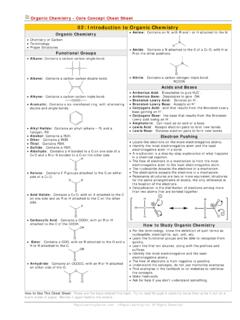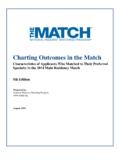Transcription of USMLE Step 1 Rapid Learning Series Course GuideBook
1 P a g e | 1 Rapid Learning Inc. All Rights Reserved USMLE step 1 Rapid Learning Series Course GuideBook P a g e | 2 Rapid Learning Inc. All Rights Reserved Table of Contents Topical Summary Series Summary Core Unit #1 Introduction to the USMLE Exam In this core unit, you will review the USMLE step 1 exam, including its format, content covered, and study tips and approaches. You will also be introduced to the structure and content of this Series . Chapter 01: Introduction to the USMLE Exam Exam structure Content covered Sample types of questions Study tips and approaches Structure and content of tutorials in this Series Core Unit #2 Human Development and Behavior In this core unit, you will review human embryology, development and aging. Human behavior and psychiatry are also reviewed, as well as biostatistics.
2 Chapter 02: Embryology Embryogenesis Congenital abnormalities Chapter 03: Human Development and Aging Developmental milestones Childhood disorders Changes in the elderly Chapter 04: Behavioral Science and Patient Treatment Epidemiology Clinical trials Ethics Behavioral physiology Chapter 05: Psychiatry Psychology Personality disorders Psychiatric diseases Pharmaceutical treatment in psychiatry Chapter 06: Biostatistics Study design Concepts of biostatistics Core Unit #3 Biochemistry and Biology In this core unit, you will review core concepts of biochemistry and biology, with an in-depth review of genetics, microbiology and immunology topics relevant to the USMLE step 1 exam. Chapter 07: Biochemistry Energy metabolism Metabolic pathways of small molecules Diseases linked to biochemical disorders P a g e | 3 Rapid Learning Inc.
3 All Rights Reserved Chapter 08: Cell Biology Cellular structure and function Protein structure and function Cellular responses to environmental changes Chapter 09: Genetics Gene expression Population genetics Clinical genetics Laboratory techniques Chapter 10: Microbiology Microbial classification Bacteria and bacterial diseases Viruses and viral diseases Fungi and fungal infections Parasites and parasitic diseases Systems microbiology Chapter 11: Immunology Immune system structure and function Normal and abnormal immune responses Therapeutics of the immune system Core Unit #4 Pathology and Pharmacology In this core unit, you will review core concepts of pathology, histology and pharmacology. Chapter 12: Pathology and Oncology Inflammation Repair mechanisms Neoplasia Chapter 13: Histology Histology laboratory techniques Tissue histology Organ system histology Chapter 14: Pharmacology Pharmacodynamics Pharmacokinetics Pharmacology of the autonomic nervous system Toxicity and drug reactions Core Unit #5 Organ Systems In this core unit, you will learn about the normal and abnormal function of the major organ systems.
4 Tutorials include clinical notes on important diseases to know for the USMLE step 1 exam. Chapter 15: The Cardiovascular System Normal cardiac processes Abnormal cardiac processes Cardiovascular therapeutics P a g e | 4 Rapid Learning Inc. All Rights Reserved Chapter 16: The Endocrine System Normal endocrine processes Abnormal endocrine processes Endocrine therapeutics Chapter 17: The Gastrointestinal System GI system anatomy GI system pathology GI system therapeutic principles Chapter 18: Hematology Normal hematopoietic processes Abnormal hematopoietic processes Hematopoietic therapeutics Chapter 19: Neurology Normal neural processes Abnormal neural processes Pharmacological treatment of neural abnormalities Chapter 20: The Skin and Musculoskeletal Systems Anatomy and physiology Pathology Pharmacology Chapter 21: The Renal System Normal renal processes Abnormal renal processes Renal system therapeutics Chapter 22.
5 The Reproductive System Reproductive system structure Normal reproductive function Abnormal reproductive function Therapeutics of the reproductive system Chapter 23: The Respiratory System Normal respiratory processes Abnormal respiratory processes Respiratory therapeutics Chapter 24: Multisystem Processes Nutrients and nutrition Adaptation to changing environments Heavy metals P a g e | 5 Rapid Learning Inc. All Rights Reserved Tutorial Series Features This tutorial Series is a carefully selected collection of core concept topics in human medicine that cover the essential concepts. It consists of three parts: USMLE step 1 Concept Tutorials 24 essential topics Problem-Solving Drills 24 practice sets Condensed Cheat Sheets 24 super review sheets Tutorials Self-contained an outline of information which would need to be supplemented by an instructor.
6 Concept map showing inter-connections of new concepts in this tutorial and those previously introduced. Definition slides introduce terms as they are needed. Visual representation of concepts. Conceptual explanation of important properties and problem solving techniques. A concise summary is given at the conclusion of the tutorial. Problem Solving Drills Each tutorial has an accompanying Problem Set with 10 problems covering the material presented in the tutorial. The problem set affords the opportunity to practice what has been learned. Condensed Cheat Sheet Each tutorial has a one-page cheat sheet that summarizes the key concepts and vocabularies and structures presented in the tutorial. Use the cheat sheet as a study guide after completing the tutorial to re-enforce concepts and again before an exam. P a g e | 6 Rapid Learning Inc.
7 All Rights Reserved Chapter by Chapter Content Guide 01: Introduction to the USMLE Exam Chapter Summary: The USMLE step 1 exam covers a number of topics, including human development and behavior; biochemistry and biology; pathology and pharmacology; and organ systems. The first lecture in this Series reviews the details of this exam. The tutorial also includes reviews of common anatomical terms and the physical exam, to lay the groundwork for the remaining tutorials in the Series . Tutorial Features: Specific Tutorial Features: Exam structure and strategies Content covered Sample types of questions Study tips and approaches Structure and content of tutorials in this Series Review of anatomical terminology The physical exam Series Features: Concept map showing inter-connections of concepts. Sample USMLE step 1 exam questions with full answers.
8 Examples given throughout to illustrate how the concepts apply. A concise summary is given at the conclusion of the tutorial. Key Concepts: The USMLE exam structure, including topics and question types Study tips and approaches for the step 1 exam Key terminology in anatomy Basics of the physical exam Chapter Review: USMLE step 1 Exam step 1 Exam: assesses understanding and application of basic science concepts in medicine, with an emphasis on principles and mechanisms underlying health, disease and therapies Students are expected to be competent in a number of knowledge areas that can be divided into two basic categories: general principles, which comprises 40-50% of the material, and organ system, which is the other 50-60% of materials. All questions in the USMLE step 1 exam are multiple-choice.
9 Questions on the USMLE fall into two categories: the one best answer format, and the clinical vignette. Never leave an answer blank unanswered questions are automatically counted as incorrect answers, and you are not penalized further for providing an incorrect answer. Review of Anatomical Terminology P a g e | 7 Rapid Learning Inc. All Rights Reserved The human body can be divided into the transverse, coronal and median planes. It has bilateral symmetry around the median plane. Directional terms describe the positions of body structures relative to other structures or locations within the body. In humans, the superior or cranial end of the body is the head, while the inferior or caudal portion is the feet. Anterior refers to the front, and posterior to the back. Lateral refers to the area away from the median plane, while medial describes a structure near the midline of the body.
10 An intermediate structure is in between lateral and medial. The terms superficial and deep are relative to the surface of the body. Abduction is the movement of a limb away from the median plane of the body, while adduction is movement towards the median plane. Adjusting the angle between two body parts may either be described as flexion, which is a movement that decreases the angle between two parts, or extension, which increases the angle between two body parts. The Physical Exam A physical exam consists of four parts: Inspection: refers to a thorough visual examination of the external features of the patient, including body features, skin color, symmetry of appearance, gait, speech patterns, frequency and volume of breaths during respiration, unusual odors or sounds. Palpation: areas of the body are felt to determine size, firmness and/or location.











